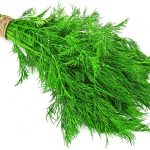 Dried ripe fruit of Anethum graveolens. Used in pickles and soups.
Dried ripe fruit of Anethum graveolens. Used in pickles and soups.
Since first being recorded in Old English twelve centuries ago, the word dill has changed very little: it has acquired a second /, originally having been spelt dil or dile, but it refers to the same herb it always did. The dill plant has, however, had other names in English as well. From the thirteenth century to the nineteenth century it was also known as anet, a name deriving from the Latin anethum, which is what the ancient Romans called the plant. Anethum is also what the ancient Romans called anise because they did not realize that dill and anise are distinct plants. In the United States in the previous century, dill seeds were also known as meetin’ seeds because they were given to children to chew during long meetings; these nineteenth-century Americans believed, like the ancient Romans, that dill had revitalizing properties, and would therefore keep the children from falling asleep.
Annual or biennial herb with a seed-like fruit.
A hardy annual, Anethum graveolens, whose leaves and seeds are used primarily to flavor foods. It is also used as an antiflatulent and antispasmodic, but scientific evidence of its effectiveness is lacking.
A towering, rather delicate-looking, yet robust plant indigenous to the Mediterranean expanse. The stalks possess a relatively strong flavor profile, while the frond-like foliage, albeit piquant, offers a highly agreeable seasoning to bland or saccharine produce, aquatic sustenance, dairy, leafy greens, and, naturally, brined vegetables. It is also commonly referred to as dill weed.
Dill, a fragrant herb similar in appearance to fennel, is native to Spain. Its seeds are commonly used to enhance the flavor of soups, sauces, and pickled foods. The oil extracted from dill seeds is distilled to produce dill water for infants. The leaves have a potent flavor and are used sparingly, either fresh or dried, in dishes such as soups, salads, and fish preparations. Dill seeds make for an uncommon yet intriguing ingredient in salads. They can be mixed into coleslaw, sprinkled over a cucumber and yogurt salad, or incorporated into yogurt or vinaigrette dressings to create a unique flavor variation. Dill is a highly sought-after herb in Scandinavia, used extensively in various culinary applications.
